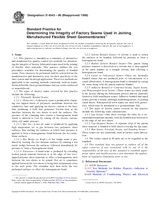Potřebujeme váš souhlas k využití jednotlivých dat, aby se vám mimo jiné mohly ukazovat informace týkající se vašich zájmů. Souhlas udělíte kliknutím na tlačítko „OK“.
ASTM D4545-86(1999)
Standard Practice for Determining the Integrity of Factory Seams Used in Joining Manufactured Flexible Sheet Geomembranes (Withdrawn 2008)
Automaticky přeložený název:
Standardní praxe pro stanovení integrity Factory švy používaných v Připojování Vyrobeno Flexibilní geomembranes Sheet (Withdrawn 2008 )
NORMA vydána dne 10.3.1999
Informace o normě:
Označení normy: ASTM D4545-86(1999)
Poznámka: NEPLATNÁ
Datum vydání normy: 10.3.1999
Kód zboží: NS-27656
Počet stran: 4
Přibližná hmotnost: 12 g (0.03 liber)
Země: Americká technická norma
Kategorie: Technické normy ASTM
Anotace textu normy ASTM D4545-86(1999) :
Keywords:
Adhesive-bonded seams, Bonded seams, Destructive testing-soil/rock, Factory seams, Field testing-geosynthet, Flexible barrier materials, Geomembranes, Liquid migration, Nondestructive evaluation (NDE), Polymers, Seam dimensions, Soil, Solvent-bonded seams, Stone, Taped seams, Thermally-bonded seams, Waterproofed seams, integrity of factory seams used in joining flexible sheet geomembranes,, summary of test procedures, practice,, Integrity
Doplňující informace
| Significance and Use |
|
The increased use of geomembranes as barrier materials to restrict liquid migration from one location to another in soil and rock, and the large number of seam methods and types used in joining these geomembrane sheets, has created a need for standard tests by which the various seams can be compared and the quality of the seam systems can be evaluated. This practice is intended to meet such a need. |
| 1. Scope |
|
1.1 This practice is intended as a summary of destructive and nondestructive quality control test methods for determining the integrity of factory fabricated seams used in the joining of flexible sheet materials. This practice outlines the test procedures available for determining the quality of bonded seams. Tests chosen to be performed shall be selected from the nondestructive and destructive tests for their specificity to the liner system and the design application. These test methods are applicable to the seaming methods commonly used on manufactured flexible sheet geomembranes that are scrim-reinforced or nonreinforced. 1.2 The types of factory seams covered by this practice include the following: 1.2.1 Thermally Bonded Seams: 1.2.1.1 Dielectric -A dielectric seam is produced by clamping two lapped sheets of polymeric membrane between two conductive bars and applying an electric current to the bars, thus producing a field that generates friction heat at the interface between the two sheets to melt the surfaces. The pressure of the clamping bars creates a homogeneous bond which is allowed to cool by cutting off the electric current, while still under pressure. 1.2.1.2 Hot Air -A hot air seam is produced by applying high temperature air or gas between two polymeric sheet surfaces, thus melting the surfaces, at which time pressure is applied to form a homogeneous bond between the two membrane surfaces. 1.2.1.3 Hot Wedge (or Knife) -A hot wedge seam is produced by melting the two intimate surfaces by running a hot metal wedge between the surfaces, followed immediately by pressure to form a homogeneous bond. 1.2.1.4 Extrusion -A bond seam is produced by extruding molten parent material between or at the edge of two overlapped polymer sheet materials to effect a homogeneous melt between the two sheets to be joined. Hot air is sometimes applied between the two sheets to bring their temperature close to the melt point. The extrudate heat then melts the two preheated surfaces to effect the homogeneous bond. 1.2.2 Solvent Bonded Seams -A solvent is used to soften the surfaces to be bonded, followed by pressure to form a homogeneous bond. 1.2.3 Bodied Solvent Bonded Seams -The parent lining polymer material is dissolved in a solvent that is then applied in the same manner as a straight solvent, thus effecting a homogeneous bond. 1.2.4 Cured or Vulcanized Seams -These are thermally bonded seams that are produced prior to vulcanization of a cured ribbon sheet. A homogeneous bond is obtained by curing the seam along with the parent material blanket. 1.2.5 Adhesive Bonded or Cemented Seams, Taped Seams, and Waterproofed Sewn Seams -These seams are rarely made at the factory during the fabrication process and are generally limited to field installation seams. Adhesive bonded and taped seams provide a means, although non-homogeneous, of joining cured sheets. Waterproofed sewn seams are used with geotextiles, which may be laminated to a geomembrane film. 1.3 The types of factory seams covered by this practice include the following seam constructions: 1.3.1 Lap Seams -One sheet overlaps the other by a recommended minimum amount, with the bonded area between or at the edge of the two sheets. 1.3.2 Cap-Stripped Seams -A separate strip of the parent sheet material is bonded to both sheets covering the lap seam. 1.3.3 Butt Seams, Envelope Seams, and Standing Seams -These seams are not commonly used in factory seam fabrication. 1.4 The values stated in SI units are to be regarded as the standard. 1.5 This standard may involve hazardous materials, operations, and equipment. This standard does not purport to address all of the safety problems associated with its use. It is the responsibility of whoever uses this standard to consult and establish appropriate safety and health practices and determine the applicability of regulatory limitations prior to use. |
Odebírejte informace o nově vydaných normách ZDARMA:
Chcete pravidelně odebírat informace o nově vycházejících normách z celého světa a to zcela zdarma?
Přihlašte se k odběru. Vše je velice jednoduché a absolutně ZDARMA.
Na výběr máte vydavatele z celého světa.




 Cookies
Cookies
